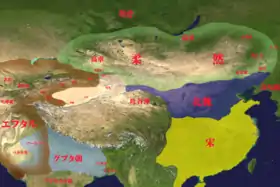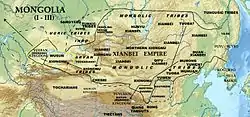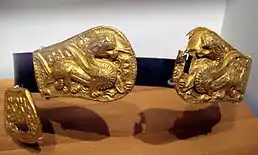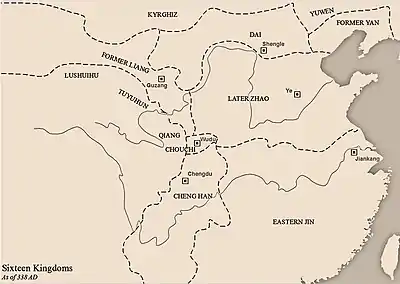Yujiulü Mugulü
Yujiulü Mugulü (Chinese: 郁久閭木骨閭; pinyin: Yùjiǔlǘ Mùgǔlǘ), or Mugului, was a Xianbei slave and the ancestor the Yujiulü clan, from whom sprang the founders of the Rouran Khaganate.[1]
| Yujiulü Mugulü 郁久閭木骨閭 | |||||
|---|---|---|---|---|---|
| Tribal chief | |||||
 Map representing rourans well to the north, located at the epicenter of the eastern steppe, in comparison to other states in its vicinity, with its area of influence extremely west and east, bordering the northern Wei state (北魏), appearing under the bluish color. | |||||
| Tribal chief of the Rouran tribe | |||||
| Reign | ?-330 or 308-316 | ||||
| Coronation | 330 or 308, Hetulin | ||||
| Predecessor | There is no, title created | ||||
| Successor | Yujiulü Cheluhui | ||||
| Regent | Yujiulü Cheluhui | ||||
| Born | Unknown 3rd century, before 277 | ||||
| Died | 4th century, 316 or after 330 | ||||
| Issue | |||||
| |||||
| Clan | Yujiulü clan | ||||
| Father | Unknown | ||||
| Mother | Unknown | ||||
| Religion | tengrism | ||||
| Occupation | Xianbei soldier, Xianbei slave (former) | ||||
| Yujiulü Mugulü | |||||||
|---|---|---|---|---|---|---|---|
| Chinese | 郁久閭木骨閭 | ||||||
| |||||||
Biography
Little is known about Mugulü's childhood, when and were he had been born, the names of his parents, as well as his consorts, were not disclosed by Book of Wei, written in Chinese language by the Tuoba Northern Wei dynasty, enemies of Mugulü's descendants, the Rourans. A parallel, mostly identical, account on Mugulu, the Yuliulü clan, and the Rouran was given in History of the Northern Dynasties.
Birth
It is likely that he was born before AD 277, at the end of Tuoba Liwei's reign.[2][3] Little to nothing is known about his childhood.
Youth and slavery under the Xianbei
According to Chinese sources, Mùgǔlǘ was a slave of unknown origin he was captured and enslaved during the reign of chief Liwei (220-277)[4][5] of the Tuoba, a Xianbei clan[6][7][8][9] most likely of Proto-Mongolic origin.[10]
Personal name
The Xianbei master called the captive was called Mùgǔlǘ, a Xianbei word glossed as "bald-headed" (首禿) in Chinese,[12] possibly owing to his appearances, his hairline starting at his eyebrow's level,[13][14] and because he did not remember his name and surname.[15] This was reconstructed as Mongolic Muqur or Muquli presumably "round, smooth" by Japanese researcher Shiratori Kurakichi.[16][17] Alexander Vovin instead proposes that Mùgúlǘ (木骨閭), in reconstructed Middle Chinese *muwk-kwot-ljo, transcribed Tuoba Xianbei *moqo-lo ~ muqo-lo 'bald head', which is analysable as 'one [who/]which has cut off/fallen off [hair]' and cognate with Mongolic lexical items like Written Mongolian moɣutur ~ moqutur 'blunt, hornless, bald tail' (cf. Chinese gloss as 禿尾 'bald tail'), moqu-ɣar, Middle Mongol muqular 'hornless', moqo-dag 'blunt'; all of those are from Proto-Mongolic *muqu 'to be cut off, break off, fall off', which in turn would produce the semantic variation 'blunt ~ hornless ~ hairless ~ bald'.[18]
Clan name
According to the Book of Wei, the dynasty founded by Mugulü's descendants was called Yujiulü, which sound superficially like Mugulü, and thus the Yùjiǔlǘ clan emerged.[19][20] Róna-Tas suggested that Yujiulü rendered *ugur(i) > Uğur, a secondary form of Oğur.;[21] Peter B. Golden additionally proposed connection with Turkic uğurluğ "feasible, opportune", later "auspicious fortunate" or oğrï "thief", an etymology more suited to the dynasty's founder's activities; additionally Yujiulü may be comparable to Middle Mongolian uğuli "owl" (> Khalkha ууль uul'), as personal names based on bird names are common in Mongolic.[22]
Other names to Mugulü
Qur ~ Qurt (from Turkic, meaning 'insect (weevil, black beetle, etc.), 'worm', or, only in Oghuz languages, 'wolf'; from "some general word for 'an unpleasant creature'"[23]): is a hypothetical reconstruction of his name by Haussig; based on the Rourans' hairstyles or totemic animals[24] or graphically pejorative exonyms which contain the 'worm, insect' 虫 radical in Chinese records.[25][26]

Lü (simplified Chinese: 闾; traditional Chinese: 閭; pinyin: Lǘ): truncated version of Yujiulü (郁久閭/闾) and Mugulü (木骨閭/闾) borne by Sinicized Rouran refugees who fled south to China after Yujiulü clan had been overthrown by the Göktürks in 551 CE and completely annihilated in 555.[27]
Mugulü's career and his escape through the Gobi

After having matured (when at least 30-year-old) or because of his strength,[28] Mugulü was emancipated; then became a warrior in the Xianbei cavalry, during the reign of Tuoba Yilu of Dai (307-316), son of Tuoba Shamohan, who was head of the Tuoba clan, Duke of Dai, and later, Prince of Dai, being the founder of this Xianbei kingdom.[29] However, he tarried past the deadline and was sentenced to death by beheading.[30] He vanished and hid amidst the Yellow Desert's streams and valleys for a time, gathered and united up to and over one hundred of escapees.[31] The escapees sought refuge under a Gaoche (Tiele) tribe called Hetulin (紇突隣).[32][33][34][35]
Death and succession
It is not known when Mugulü died, sources say 316 AD[36] or after 330 AD,[37] nor is the cause of death known.
After Mugulü's death, his son Cheluhui became a courageous, rough hero, acquired his own tribal horde and either he was or his tribe were called Rouran.[38][39] Cheluhui's government was marked by nomadism and peace,[40] but they remained subjects to the Xianbei Tuobas.[41][38] Later, he would be succeeded by his son, Tunugui, son of Cheluhui and grandson of Mugulü.[42]
Foundation of the Rouran tribe and legacy
Around 330,[38] Mugulü's descendants multiplied into the Yujiulü clan. Mugulü's son Cheluhui gathered and led an independent tribe, self-proclaimed Rouran.[38] Much later, Yujiulü Shelun (or Jarun), turns his tribe into a vast nomadic empire,[43] which would be overthrown in 551 by their subjects, the Göktürks,[44][45][46][47][48] under the leadership of Ashina Tumen (real name Bumin).[49] Bumin's second son Muqan Qaghan, allying with the Sinicized Xianbei Northern Zhou dynasty, completely annihilated the Rourans in 555, effectively replacing the dynastic rule of the Yujilü clan with the Ashina tribe's rule and establishing the first empire of the nomadic Turkic peoples.[50]
Descendants of Mugulü
| The family tree of the Khaghans of the Rouran | |||||||||||||||||||||||||||||||||||||||||||||||||||||||||||||||||||||||||||||||||||||||||||||||||||||||||||||||||||||||||||||||||||||||||||||||||||||||||||||||||||||||||||||||||||||||||||||||||||||||||||||||||||||||||||||||||||||||||||||||||||||||||||||||||||||||||||||||||||||||||||||||||||||||||||||||||||||||||||||||||||||||||||||||||||||||||||||||||||||||||||||||||||||||||||||||||||||||||||||||||||||||||||||||||||||||||||||||||||||||||||||||||||||||||||||||||||||||||||||||||||||||||||||||||||||||||||||||||||||||||||||||||||||||||||||||||||||||||||||||||||||||||||||||||||||||||||||||||||||||||||||||||||||||||||||||||||||||||||||||||||||||||||||||||||||||||||||||||||||||||||||||||||||||||||||||||||||||||||||||||||||||||||||||||||||||||||||||||||||||||||||||||||||||||||||||||||||||||||||||||||||||||||||||||||||||||||||||||||||||||||||||||||||||||||||||||||||||||||||||||||||||||||||||||||||||||||||||||||||||||||||||||||||||||||||||||||||||||||||||||||||||||||||||||||||||||||||||||||||||
|---|---|---|---|---|---|---|---|---|---|---|---|---|---|---|---|---|---|---|---|---|---|---|---|---|---|---|---|---|---|---|---|---|---|---|---|---|---|---|---|---|---|---|---|---|---|---|---|---|---|---|---|---|---|---|---|---|---|---|---|---|---|---|---|---|---|---|---|---|---|---|---|---|---|---|---|---|---|---|---|---|---|---|---|---|---|---|---|---|---|---|---|---|---|---|---|---|---|---|---|---|---|---|---|---|---|---|---|---|---|---|---|---|---|---|---|---|---|---|---|---|---|---|---|---|---|---|---|---|---|---|---|---|---|---|---|---|---|---|---|---|---|---|---|---|---|---|---|---|---|---|---|---|---|---|---|---|---|---|---|---|---|---|---|---|---|---|---|---|---|---|---|---|---|---|---|---|---|---|---|---|---|---|---|---|---|---|---|---|---|---|---|---|---|---|---|---|---|---|---|---|---|---|---|---|---|---|---|---|---|---|---|---|---|---|---|---|---|---|---|---|---|---|---|---|---|---|---|---|---|---|---|---|---|---|---|---|---|---|---|---|---|---|---|---|---|---|---|---|---|---|---|---|---|---|---|---|---|---|---|---|---|---|---|---|---|---|---|---|---|---|---|---|---|---|---|---|---|---|---|---|---|---|---|---|---|---|---|---|---|---|---|---|---|---|---|---|---|---|---|---|---|---|---|---|---|---|---|---|---|---|---|---|---|---|---|---|---|---|---|---|---|---|---|---|---|---|---|---|---|---|---|---|---|---|---|---|---|---|---|---|---|---|---|---|---|---|---|---|---|---|---|---|---|---|---|---|---|---|---|---|---|---|---|---|---|---|---|---|---|---|---|---|---|---|---|---|---|---|---|---|---|---|---|---|---|---|---|---|---|---|---|---|---|---|---|---|---|---|---|---|---|---|---|---|---|---|---|---|---|---|---|---|---|---|---|---|---|---|---|---|---|---|---|---|---|---|---|---|---|---|---|---|---|---|---|---|---|---|---|---|---|---|---|---|---|---|---|---|---|---|---|---|---|---|---|---|---|---|---|---|---|---|---|---|---|---|---|---|---|---|---|---|---|---|---|---|---|---|---|---|---|---|---|---|---|---|---|---|---|---|---|---|---|---|---|---|---|---|---|---|---|---|---|---|---|---|---|---|---|---|---|---|---|---|---|---|---|---|---|---|---|---|---|---|---|---|---|---|---|---|---|---|---|---|---|---|---|---|---|---|---|---|---|---|---|---|---|---|---|---|---|---|---|---|---|---|---|---|---|---|---|---|---|---|---|---|---|---|---|---|---|---|---|---|---|---|---|---|---|---|---|---|---|---|---|---|---|---|---|---|---|---|---|---|---|---|---|---|---|---|---|---|---|---|---|---|---|---|---|---|---|---|---|---|---|---|---|---|---|---|---|---|---|---|---|---|---|---|---|---|---|---|---|---|---|---|---|---|---|---|---|---|---|---|---|---|---|---|---|---|---|---|---|---|---|---|---|---|---|---|---|---|---|---|---|---|---|---|---|---|---|---|---|---|---|---|---|---|---|---|---|---|---|---|---|---|---|---|---|---|---|---|---|---|---|---|---|---|---|---|---|---|---|---|---|---|---|---|---|---|---|---|---|---|---|---|---|---|---|---|---|---|---|---|---|---|---|---|---|---|---|---|---|---|---|---|---|---|---|---|---|---|---|---|---|---|---|---|---|---|---|---|---|---|---|---|---|---|---|---|---|---|---|---|---|---|---|---|---|---|---|---|---|---|---|---|---|---|---|---|---|---|---|---|---|---|---|---|---|---|---|---|---|---|---|---|---|---|---|---|---|---|---|---|---|---|---|---|---|---|---|---|---|---|---|---|---|---|---|---|---|---|---|---|---|---|---|---|---|---|---|---|---|---|---|---|---|---|---|---|---|---|---|---|---|---|---|---|---|---|---|---|---|---|---|---|---|---|---|---|---|---|---|---|---|---|---|---|---|---|---|---|---|---|---|---|---|---|---|---|---|---|---|---|---|---|---|---|---|---|---|---|---|---|---|---|---|---|---|---|---|---|---|---|---|---|---|---|---|---|---|---|---|---|---|---|---|---|---|---|---|---|---|---|---|---|---|---|---|---|---|---|---|---|---|---|---|---|---|---|---|---|---|---|---|---|---|---|---|---|---|---|---|---|---|---|---|---|---|---|---|---|---|---|---|---|---|---|---|---|---|---|---|---|---|---|---|---|---|---|---|---|---|---|---|---|---|---|---|---|---|---|---|---|---|---|---|---|---|
| |||||||||||||||||||||||||||||||||||||||||||||||||||||||||||||||||||||||||||||||||||||||||||||||||||||||||||||||||||||||||||||||||||||||||||||||||||||||||||||||||||||||||||||||||||||||||||||||||||||||||||||||||||||||||||||||||||||||||||||||||||||||||||||||||||||||||||||||||||||||||||||||||||||||||||||||||||||||||||||||||||||||||||||||||||||||||||||||||||||||||||||||||||||||||||||||||||||||||||||||||||||||||||||||||||||||||||||||||||||||||||||||||||||||||||||||||||||||||||||||||||||||||||||||||||||||||||||||||||||||||||||||||||||||||||||||||||||||||||||||||||||||||||||||||||||||||||||||||||||||||||||||||||||||||||||||||||||||||||||||||||||||||||||||||||||||||||||||||||||||||||||||||||||||||||||||||||||||||||||||||||||||||||||||||||||||||||||||||||||||||||||||||||||||||||||||||||||||||||||||||||||||||||||||||||||||||||||||||||||||||||||||||||||||||||||||||||||||||||||||||||||||||||||||||||||||||||||||||||||||||||||||||||||||||||||||||||||||||||||||||||||||||||||||||||||||||||||||||||||||
See also

Succession
Yujiulü Mugulü Born: 3rd century, before 277 Died: 4th century, 316 or after 330 | ||
| Regnal titles | ||
|---|---|---|
| Preceded by None, title created |
Tribal chief of rourans 330–? |
Succeeded by Yujiulü Cheluhui |
Bibliography
Sources
- 『魏書』(列伝第九十一 蠕蠕)
- 『北史』(列伝第八十六 蠕蠕)
- 『魏書』(列伝第九十一 蠕蠕)
- 『北史』(列伝第八十六 蠕蠕)
- 内田吟風、田村実造他訳注『騎馬民族史1 正史北狄伝』(平凡社東洋文庫、1971年)
- 内田吟風『北アジア史研究 匈奴篇』(同朋舎〈東洋史研究叢刊〉、1975年、ISBN 481040627X)
- 《魏书·蠕蠕传》
- 《北史·蠕蠕传》
- "Book of Jin·Volume 125·Record of the Twenty-fifth"
- "Southern Qishu·Volume 59·Biographies 40"
- "Wei Shu·Volume 103·Biography 91"
- "Northern History·Volume Ninety-Eight·Biography 68"
- Zhou Weizhou "Tiele and Rouran"
- Wei Shu (554), Unknown (ed.), Wei Shu, Vol. 103, Unknown
- Grousset (1970), The Empire of the Steppes
Monograph
- 内田吟風、田村実造他訳注『騎馬民族史1 正史北狄伝』 平凡社東洋文庫, 1971.
References
- Grousset (1970), pp. 61, 585, n. 91.
- Weishu vol. 103 始神元之末,掠騎有得一奴 tr. "In the beginning of the end of the Shenyuan, a [Tuoba] raider cavalryman acquired a slave"
- Golden, Peter B. "Some Notes on the Avars and Rouran", in The Steppe Lands and the World beyond Them. Ed. Curta, Maleon. Iași (2013). p. 54-56.
- Weishu vol. 103 始神元之末,掠騎有得一奴 tr. "In the beginning of the end of the Shenyuan, a [Tuoba] raider cavalryman acquired a slave"
- Golden, Peter B. "Some Notes on the Avars and Rouran", in The Steppe Lands and the World beyond Them. Ed. Curta, Maleon. Iași (2013). p. 55.
- Wei Shou. Book of Wei. Vol. 1
- Grousset, Rene (1970). The Empire of the Steppes. Rutgers University Press. pp. 60–65. ISBN 0-8135-1304-9.
- Holcombe, Charles (2001). The Genesis of East Asia: 221 B.C. - A.D. 907. p. 131.
- Tseng, Chin Yin (2012). The Making of the Tuoba Northern Wei: Constructing Material Cultural Expressions in the Northern Wei Pingcheng Period (398-494 CE) (PhD). University of Oxford. p. 1.
-
- Pulleyblank, Edwin G. (2000). "Ji 姬 and Jiang 姜: The Role of Exogamic Clans in the Organization of the Zhou Polity", Early China. p. 20
- Grousset, Rene (1970). The Empire of the Steppes. Rutgers University Press. pp. 57. ISBN 0-8135-1304-9.
- Weishu vol. 103 "其主字之曰木骨閭。「木骨閭」者,首禿也。"
- Weishu, "Vol. 103" "髮始齊眉 [...] 首禿也"
- Weishu Vol. 103 "髮始齊眉"
- vol. 103 "忘本姓名"
- 白鳥庫吉 1910; 内田吟風 1971: 218.
- Ginfu 1971, p. 218, note 4.
- Vovin, Alexander. 2007. "Once again on the Tabγač language", Mongolian Studies, XXIX: 200-202
- Weishu Vol. 103 txt. "木骨閭與郁久閭聲相近,故後子孫因以為氏。" tr. "Mugulü and Yujiulü sound similar; hence [Mugulü's] descendants later used as surname"
- Lee, Joo-Yup (2015-12-04). Qazaqlïq, or Ambitious Brigandage, and the Formation of the Qazaqs: State and Identity in Post-Mongol Central Eurasia. BRILL. p. 52. ISBN 9789004306493.
- Róna-Tas, András. (1999). Hungarians and Europe in the early Middle Ages : an introduction to early Hungarian history. Budapest: Central European University Press. pp. 210–211. ISBN 9639116483. OCLC 654357432.
- Golden, Peter B. "Some Notes on the Avars and Rouran", in The Steppe Lands and the World beyond Them. Ed. Curta, Maleon. Iași (2013). p. 55.
- Clauson, Gerard (1972). An Etymological Dictionary of Pre-13th Century Turkish. Oxford University Press. p. 648.
- Theobald, Ulrich (2012) Rouran 柔然 for ChinaKnowledge.de - An Encyclopaedia on Chinese History, Literature and Art
- Haussig 1953; in Uchida 1971: 218.
- Uchida 1971, p. 218, note 4.
- Gao Yang. "The Origin of the Turks and the Turkish Khanate", X. Türk Tarih Kongresi: Ankara 22 – 26 Eylül 1986, Kongreye Sunulan Bildiriler, V. Cilt, Türk Tarih Kurumu, 1991, p. 730-731.
- Weishu vol. 103. The phrase "木骨閭既壯" is translatable as literally "Mugulü, because of [his] robustness", or - figuratively - "Mugulü, because of [his] maturity"; cf. Liji "Quli I txt: "三十曰壯" tr: "When he is thirty, we say, 'He is at his maturity;'" by James Legge
- Weishu vol. 103 "免奴為騎卒。穆帝時" tr. "[he was] release[d] from slavery and made a cavalry soldier, during the time of Emperor Mu (of Dai)"
- Weishu vol. 103 "坐後期當斬"
- Weishu vol. 103 "亡匿廣漠谿谷間, 逋逃得百餘人
- Weishu vol. 103, Ruru "依紇突隣部" tr. "[They] relied on the Hetulin tribe"
- The corresponding passage in Beishi vol. 98 Ruru reads "依純突鄰部" tr. "[They] relied on the Chuntulin tribe" or "[They] relied on the pure Tulin tribe"
- Both Weishu, Vol. 103, Gaoche and Beishi Vol. 98, Gaoche have "又有紇突隣" tr. "[There] were also the Hetulin tribe"
- Bozan 1962, p. 225.
- Lee 2015, pp. 51–52.
- Yıldırım 2013, p. 35.
- Pohl 2018, p. 33.
- Weishu Vol. 103 "木骨閭死,子車鹿會雄健,始有部眾,自號柔然" "Mugulü died; [his] son Cheluhui, virile and robust, began to gather the tribal multitude, [his/their] self-appellation Rouran"
- Weishu, vol. 103 "車鹿會既為部帥,歲貢馬畜、貂豽皮,冬則徙度漠南,夏則還居漠北。"Cheluhui, since made tribal chief, [paid] annual tributes in horses, livestock, [as well as] skins of martens and seals. in winter [they] moved southwards across the desert; in summer [they] returned northwards to dwell in the desert."
- Weishu Vol. 103 "而役屬於國。後世祖以其無知,狀類於蟲,故改其號為蠕蠕。" tr. "yet [Cheluhui/Rouran] [was/were] vassal(s) of (our) state.
- Weishu, vol. 103 "車鹿會死,子吐奴傀立" tr. "Cheluhui died, [his] son Tunugui [was] established [as ruler]."
- Book of Wei, Vol. 103
- 馬長壽, 《突厥人和突厥汗國》, 上海人民出版社, 1957, (Ma Zhangshou, Tujue ve Tujue Khaganate), pp. 10-11. (in Chinese)
- 陳豐祥, 余英時, 《中國通史》, 五南圖書出版股份有限公司, 2002, ISBN 978-957-11-2881-8 (Chen Fengxiang, Yu Yingshi, General history of China), p. 155. (in Chinese)
- Gao Yang, "The Origin of the Turks and the Turkish Khanate", X. Türk Tarih Kongresi: Ankara 22 - 26 Eylül 1986, Kongreye Sunulan Bildiriler, V. Cilt, Türk Tarih Kurumu, 1991, s. 731.
- Burhan Oğuz, Türkiye halkının kültür kökenleri: Giriş, beslenme teknikleri, İstanbul Matbaası, 1976, p. 147. «Demirci köle» olmaktan kurtulup reisleri Bumin'e (in Turkish)
- Larry W. Moses, "Relations with the Inner Asian Barbarian", ed. John Curtis Perry, Bardwell L. Smith, Essays on Tʻang society: the interplay of social, political and economic forces, Brill Archive, 1976, ISBN 978-90-04-04761-7, p. 65. text: "Slave' probably meant vassalage to the Juan Juan confederation of Mongolia, whom they served in battle by providing iron weapons, and also marching with qaghan's armies.
- "Tumen" is used for expressing 10,000 and "Bum" is used for expressing 100,000 in Secret History of the Mongols, Larry Moses, "Legend by the numbers: The Symbolism of Numbers in the 'Secret History of the Mongols'", Asian folklore studies, Vol. 55-56, Nanzan University Institute of Anthropology, 1996, p. 95.
- Pohl 2018, p. 36.
- "隋代《郁久闾伏仁墓志》考释-中国文物网-文博收藏艺术专业门户网站" [An Interpretation of the Epitaph of Yujiulü Furen]. www.wenwuchina.com. Retrieved 2019-11-09.

